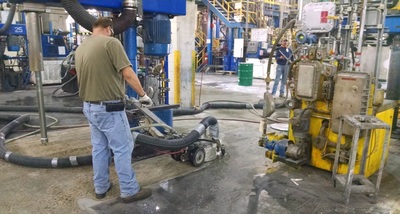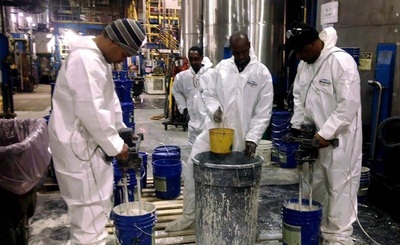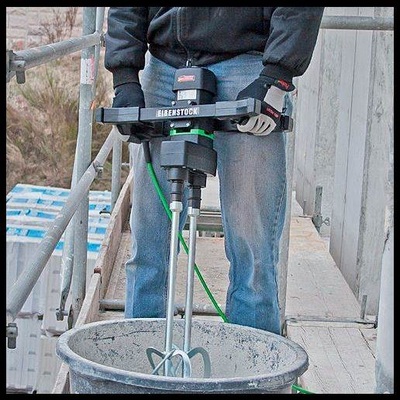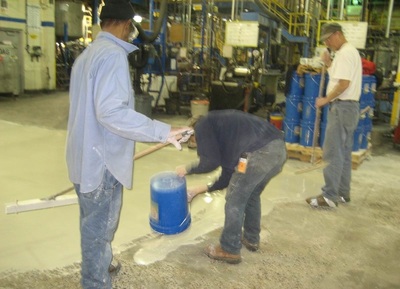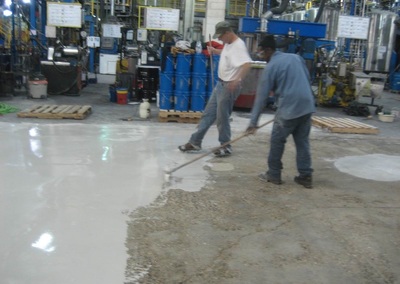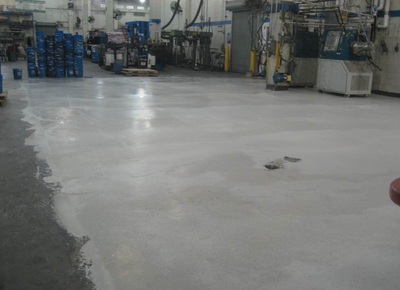| Agrirok Case Study - Industrial Paint Shop |
Case Study for Industrial Paint Shop
Heavy-duty concrete overlay for an industrial floor
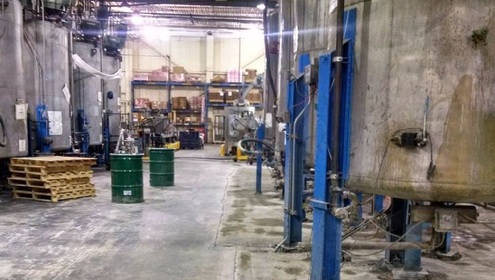
Problem: Degraded Epoxy Floor Topping
A major paint manufacturing facility had problems with their carbon filled epoxy floor topping: the solvents they used to mop the floor (to remove stubborn pain residue) would soften the epoxy and heavy duty fork lift traffic would cause the epoxy to lift from the concrete substrate. Once the solvent was exposed to the concrete, it started eating away at the Portland cement leaving exposed aggregate.
Special Floor Requirements
The new floor solution had to meet certain requirements:
‘Grind-and-Polish’ concrete performed adequately; however the total downtime of complete epoxy removal, concrete restoration and a costly finishing procedure exceeded their requirements.
A major paint manufacturing facility had problems with their carbon filled epoxy floor topping: the solvents they used to mop the floor (to remove stubborn pain residue) would soften the epoxy and heavy duty fork lift traffic would cause the epoxy to lift from the concrete substrate. Once the solvent was exposed to the concrete, it started eating away at the Portland cement leaving exposed aggregate.
Special Floor Requirements
The new floor solution had to meet certain requirements:
- Durable enough to withstand moving paint mixing vats and tow motor traffic
- Resistant to floor cleaning solvents and paint solvents
- Anti-static properties (preventing static discharge)
- Cure time in under 12 hours
‘Grind-and-Polish’ concrete performed adequately; however the total downtime of complete epoxy removal, concrete restoration and a costly finishing procedure exceeded their requirements.
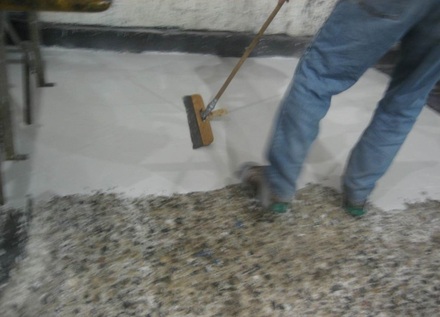
Solution: Agri-Rok
CCSI suggested Agri-Rok as a more cost-effective and durable alternative to ‘grind-and-polish’ concrete. Agri-Rok is a rapid-set surfacing concrete containing a lithium silicate and colloidal silica blend of densifiers. It provides a harder and more chemical resistant finish than typical concrete and cures for industrial use in less than 8 hours.
Agri-Rok provides the following benefits:
CCSI suggested Agri-Rok as a more cost-effective and durable alternative to ‘grind-and-polish’ concrete. Agri-Rok is a rapid-set surfacing concrete containing a lithium silicate and colloidal silica blend of densifiers. It provides a harder and more chemical resistant finish than typical concrete and cures for industrial use in less than 8 hours.
Agri-Rok provides the following benefits:
- Restoration of the concrete surface grade from 3/8th inch to a feathered edge
- A compressive strength similar to carbon filled epoxy
- An extremely non-porous surface
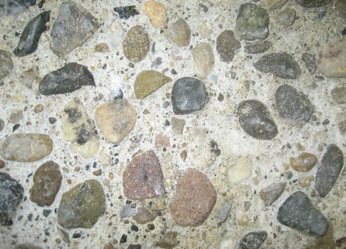
Testing Agri-Rok Performance
A 10 X 10 sample of Agri-Rok was installed in a section of floor where the epoxy had peeled off and the concrete had degraded to expose large aggregate. The epoxy was removed and ¼“ Argri-Rok poured on and leveled. After 8 hours cure time, the sample floor area was ready for industrial use.
Agri-Rok had met all the client’s requirements. This became the first of three subsequent floor restoration projects.
A 10 X 10 sample of Agri-Rok was installed in a section of floor where the epoxy had peeled off and the concrete had degraded to expose large aggregate. The epoxy was removed and ¼“ Argri-Rok poured on and leveled. After 8 hours cure time, the sample floor area was ready for industrial use.
Agri-Rok had met all the client’s requirements. This became the first of three subsequent floor restoration projects.
Installation
High Pressure water was used to remove the old epoxy topping. For edge work, air operating pogo sticks and chipping hammers were used. The terminal edges of the repair were saw-cut and chipped. An Agri-Rok Mix station was set up on pallets over a plastic tarp. Two dual counter-rotating ribbon mixers were used to blend Agri-Rok powder and water.
High Pressure water was used to remove the old epoxy topping. For edge work, air operating pogo sticks and chipping hammers were used. The terminal edges of the repair were saw-cut and chipped. An Agri-Rok Mix station was set up on pallets over a plastic tarp. Two dual counter-rotating ribbon mixers were used to blend Agri-Rok powder and water.
These mixers from Eibenstock are designed for mixing highly viscous and stiff materials. It has a soft start, temperature control, stepless speed regulation and constant speed. It uses two contra-rotating stirring rods and have shown that this tool cuts the mix time by half. The mixer also eliminates bucket spinning and reduces installed physical strain because of reduced torque.
The floor was vacuumed and water was sprayed onto the concrete to a surface-saturated condition. This prevents potential cracking of Agri-Rok by the concrete absorbing water from the mix.
The floor was vacuumed and water was sprayed onto the concrete to a surface-saturated condition. This prevents potential cracking of Agri-Rok by the concrete absorbing water from the mix.
From the mix station, the Agri-Rok was poured onto the floor. One man screeds the material to approximately ¼” using a gage rake. After gaging, the material was smoothed using a magic trowel (a squeegee or hand trowel could also be used). Any Agri-Rok which spilled over the saw cuts was marked with a trowel. After the material cured to a putty consistency, it was easily scraped off using a scraper or trowel. After the Agri-Rok surface had cured about 2 hours, a uniform application of CS/LS densifier was applied to the Agri-Rok by pump-up sprayer. This application retarded water evaporation and further sealed and densified the Agri-Rok surface.
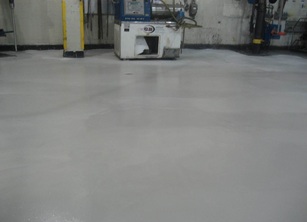
Conclusion
The client was pleased that after the Agri-Rok surface cured for 8 hours, the plant could go back into production.
Summary
Agri-Rok Concrete Overlay is a one-component, rapid hardening, early strength gaining, cementitious overlay material for concrete.
Where to Use
Advantages
Agri-Rok Concrete Overlay is a one-component, rapid hardening, early strength gaining, cementitious overlay material for concrete.
Where to Use
- On any concrete surface (at, above or below grade)
- On horizontal or vertical repairs of concrete with previous chemical damage
- On floors that need re-sloping (from 4” to feather edge)
Advantages
- Rapid cure (Open to foot traffic in two hours, vehicle traffic in seven hours)
- High chemical resistance (compared to Portland cement)
- Easy to apply with little equipment and unspecialized labor
- Semi self-leveling
- Freeze/thaw resistant
- Semi-breathable (not a vapor barrier)
- Excellent patching material
- Compatible with Epoxy coatings after 7 hours cure
| Agrirok Case Study - Industrial Paint Shop |
